So you’re running a cart recovery email sequence and you’re seeing a good return. Brilliant.
Your cart recovery emails are prime for testing.
- Split-testing subject lines
- Split-testing email copy
- Split-testing call-to-action buttons
You should have a programme of continual optimisation in place. Testing ways to incentivise open, click and conversion rates.
Then there’s segmentation. How do you differentiate your email copy dependent upon the products people are shopping for?
- Do you send the same message when somebody’s spending £250 as another potential customer spending £25?
- Do you send the same message when somebody has already qualified for free shipping compared with somebody who’s just £10 outside the cut-off?
- Do you use the same copy for new and returning customers?
There’s a stack of learning to be made. There’s a stack of money to be made.
Cart abandonment email series represent a huge opportunity for you to win back prospective buyers. No matter how many orders you’re receiving per day. This is a percentage game where data insight is key to success.
How crucial is the timing of your cart recovery email series?
Basic cart recovery campaigns, such as those offered by MailChimp, allow you to select the timing of your email. You can choose to wait to deliver your email by the hour or by the day.
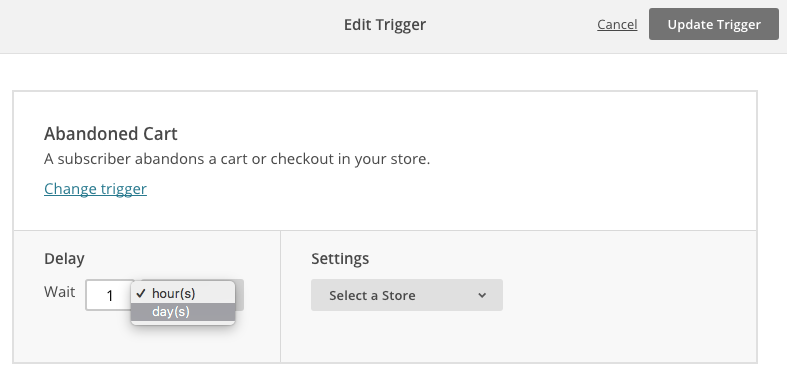
How to setup a simple Cart Abandonment recovery campaign using MailChimp
Similarly, for Shopify customers, you have the ability to choose the timing of your campaign
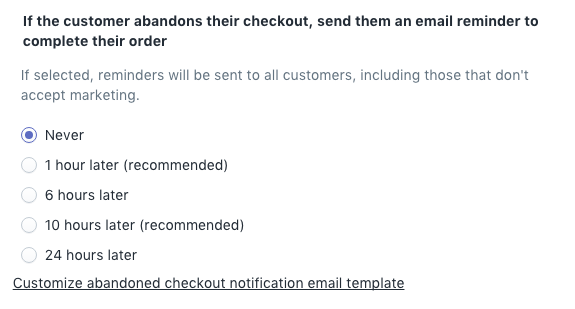
How to setup a simple Cart Abandonment recovery campaign using Shopify
Changing the timing of your campaign is simple. Knowing which time works best? It gets a little more advanced.
What you need to consider when timing your cart recovery campaign
What are your peak buying hours?
Fashion retailers typically see greater volume of transactions during the evening.
Let’s say, for example, 8-9pm is your best hour for sales.
Sending your campaign on a 6 hour or 12 hour delay will make little sense. Your shoppers will be picking up the email first thing in the morning. They’ll have other things on their mind then.
24 hours for an initial cart recovery email? Probably too late.
We want to reach people whilst they’re still in buying mode.
So, first question we need to answer: What’s the best time to drop that initial cart recovery email? Timing really is key.
The only way to validate any theory is through testing.
Unfortunately, with the most popular cart abandonment tools offered by Mailchimp and Shopify you’re unable to a/b test. Instead, you run a timed campaign for 2-4 weeks. Once the initial run is completed you then run for the same people and compare results.
There is a problem though.
Like with any test where you take a chunk of data from one time period and compare with another, there’s outside influence on results. Consider what my impact the overall validity of your test if you’re running concurrent tests rather than a/b split tests:
- Seasonality
- Price promotions
- Product availability
- Average price point of email newsletter campaigns you’re running
- Changes in referral source of website traffic
Data gets skewed. You don’t want to work with skewed data.
Instead you a/b test.
The platform: This does mean that you need to invest a little more time (and perhaps money) into ensuring your email software platform includes a/b testing. Klaviyo is always my preferred option for any ecommerce business serious about growth.
The validation: You need to get enough data in the pot to prove any theory you may have. Your objective with any test is to reach the point of statistical significance.
I like the definition of statistical significance offered up by OmniConvert:
The term statistical significance is used in market research to define the probability that a measured difference between two statistics is the result of a real difference in the tested variations and not the result of chance. It means that the result of a test didn’t appear randomly or by chance, but because of a specific change that was tested, so it can be attributed to a specific cause.
How to use Klaviyo to a/b test cart recovery campaign timing
I’m using Klaviyo as it’s where I have seen the best results for ecommerce clients. You may have access to similar a/b test settings within your own email service provider.
a/b testing subject fields and email content is a doddle within Klaviyo. You click ‘add variation’ and have access to a range of choices to test and launch:
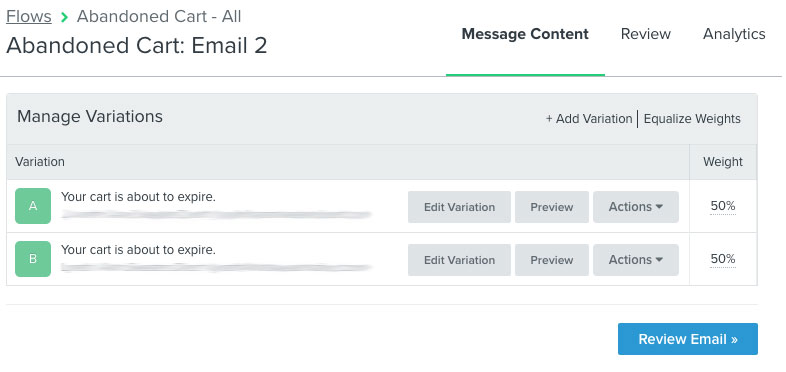
Setting up a simple a/b test of an abandoned cart recovery email in Klaviyo
That’s fine for a/b testing copy and subject lines, but what about testing email timing?
This takes a little more constructive work. Let’s say we want to test the response rates of:
- Cart recovery 2-email series after 1 and 6 hours
- Cart recovery 2-email series after 1 and 24 hours
Step 1.) Setup a cart abandonment email flow with a normal a/b test where variation a and b are both the same email (as per example above).
Step 2.) Setup your second email within the flow including an additional filter that restricts sending the email to only 1 particular variant of the 1st email (50% of recipients) – see below
Step 3.) Setup your third email (the exact same as step 2) to be sent to those that skipped step 2
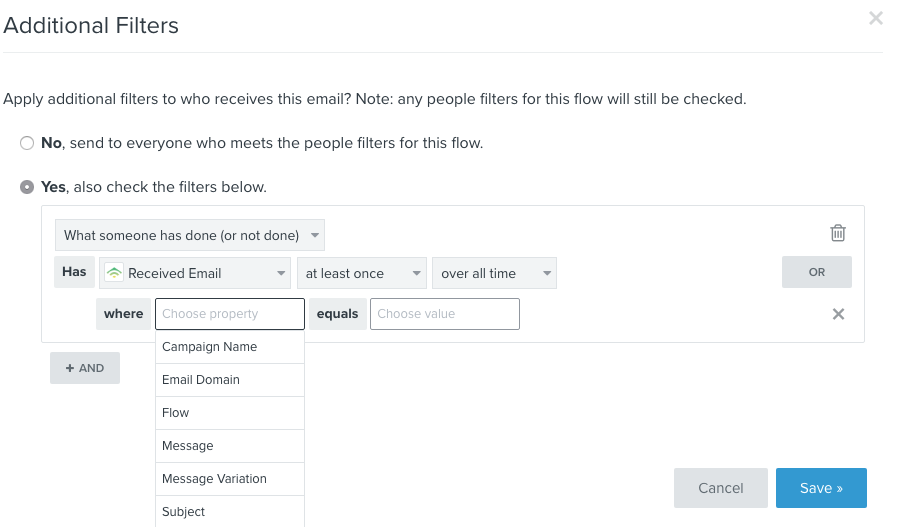
How to setup additional filters within an email flow using Klaviyo
So what you’re telling your email sequence to do is funnel 50% of your traffic into the next stage of the flow.
You’ll then need to ensure that the final email (24hr in this example) isn’t sent to the recipients of the 6hr email.
Adopting this methodology will allow you to gradual form a better understanding of what frequency and timing works best for your cart recovery process. You’ll be able to quickly map out the email flow to get a better understanding of the overall effectiveness of your optimisation process

Basic diagram of an email flow series using filters
The great thing is that this will not take up much of your time. Like most a/b tests, they can run in the background.
Again, this is an optimisation process. The end result is determined by the amount of revenue you have earned.
Klaviyo’s reporting is brilliant. I’d always recommend, however, keeping tab of the results creating your own Google sheets with a simple layout of KPIs. See the example below:
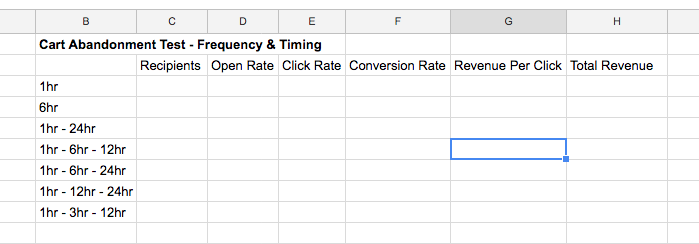
Keeping tabs of a/b testing results within Google Sheets
How long should you run your cart abandonment a/b tests for?
This is down to the volume of transactions you’re placing through your online store. In the early days of your testing you’ll see volatility. One test will look like it’s flying ahead. You’ll come under pressure to switch the a/b test off. Resist that pressure! Your data could be skewed by larger than usual orders.
This is an optimisation process that can run in the background as you build up data. You’re looking to reach that sweet spot of understanding the volume of cart abandonment emails to send and the timing of those campaigns.
During the process you may be tempted to change the wording or subject lines of the campaigns. Hold off! That’s a totally separate process which you can run at a later date.
For this particular test you’re working to one simple hypothesis:
What is the best time and frequency to dispatch our cart abandonment email series?
Klaviyo have also reported on the average open rate, click rate, revenue per recipient and conversion revenue relating to the frequency of cart abandonment campaigns you dispatch.

Benchmark Data on Expected Open Rates For Cart Abandonment Campaigns
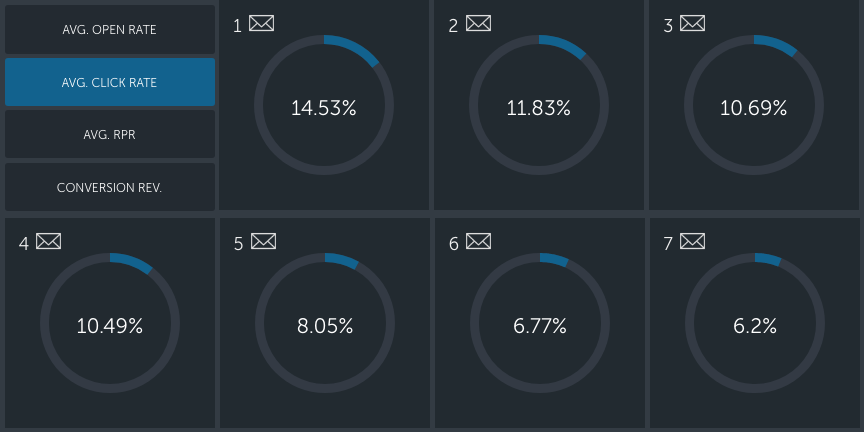
Benchmark Data on Expected Click Rates For Cart Abandonment Campaigns
You will see a deterioration in both open and click rates as your email sequence progresses. This, however, is about incremental revenue. Revenue you may not have earned if you were restricting your cart abandonment campaign to just one single email.
3 further considerations as you run your cart recovery series testing:
- As you progress with your cart abandonment campaign optimisation try to minimise the skewing of results for each individual test by testing like for like data.
- Don’t test the dispatch of single 1 hour email versus a complex 5-step 1/6/12/24/48 campaign. First test timings and then test volume.
- Don’t forget that these are real people, real customers, that are receiving your test emails. Keep in mind the frustration of bombardment. You don’t want your tests to annoy people to the stage they blacklist your brand for their next purchase.
Final advice. There are some big hefty wins when testing the success of your cart recovery campaigns. Work to a structure as you begin to test your campaign timing and frequency. You can’t just dabble. This is about learning what works and what works even better. Furthermore, what worked well for another ecommerce business? May not work well for you. This is why I can’t simply present you with a ‘Ten Steps To Doubling Your Cart Abandonment Campaign Revenue’ article. Ignore those that make sweeping generalisations about what will work for you. They don’t know your customers.
Savvy ecommerce marketing is all about organised work. Switching on your cart abandonment campaign will have brought in more revenue. Switching on your cart abandonment optimisation process? It’s your job to find out just how much more money you can earn your business.

